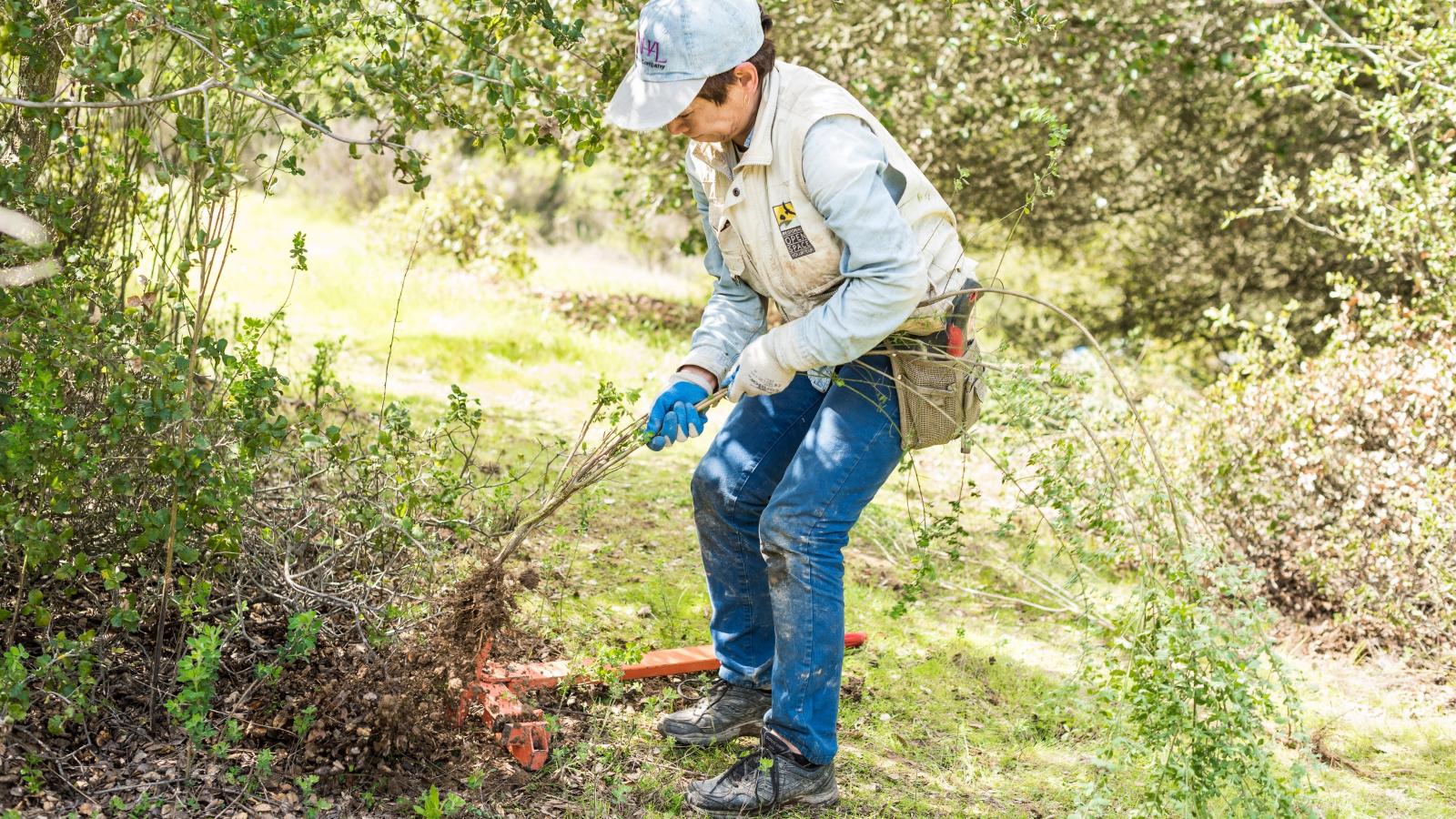Integrated Pest Management is a method for efficiently managing plant and animal pests while protecting human health and the environment. Midpen adopted an IPM Guidance Manual to direct its management of harmful invasive plants and animals on preserves, as well as rodents and insects in Midpen-owned buildings.
Midpen biologists develop specific multi-year IPM plans based on the biology of the pest, ecological conditions at the treatment site and any potential secondary impacts such as soil erosion. Nonchemical techniques to control pests, like prevention, pulling, cutting, digging, mowing and/or setting traps, are considered before chemical methods.
In 2018, the California Department of Pesticide Regulation recognized Midpen's leadership in the Integrated Pest Management field with an IPM Achievement Award.


Stay informed!
Invasive Species Control
An invasive species is a plant or animal, often not originating from the local area, that has competitive advantages that allow its population to expand rapidly, reducing biodiversity in ways that often cause ecological and/or economic harm.
Midpen follows a strategic plan when dealing with invasive species and Midpen biologists prioritize treatment using the best science. Of particular concern are invasive plants that threaten rare native species or sensitive natural communities. Through this process, Midpen determines the best treatment approach and long-term management plan for the site.
Applying adaptive management practices, Midpen staff update work plans on an annual basis based on prior treatment results, new environmental conditions and any new invasive species sightings made by Midpen staff, volunteers or contractors, as well as community scientists like you using observation apps like iNaturalist. Midpen strictly adheres to the best management practices outlined in the Integrated Pest Management Program and updates them as the science of weed management evolves to ensure the safety of all those inhabiting our preserves.
Some invasive species that Midpen is currently monitoring and managing, often with support from volunteers, are:
- barbed goatgrass (Aegilops triuncialis)
- bigleaf periwinkle (Vinca major)
- bull thistle (Cirsium vulgare)
- French broom (Genista monspessulana)
- Fuller's teasel (Dipsacus sativus)
- Italian thistle (Carduus pycnocephalus)
- jointed goatgrass (Aegilops cylindrica)
- medusahead (Elymus caput-medusae)
- poison hemlock (Conium maculatum)
- purple starthistle (Centaurea calcitrapa)
- slender false-brome (Brachypodium sylvaticum)
- Spanish broom (Spartium junceum)
- stinkwort (Dittrichia graveolens)
- summer mustard (Hirschfeldia incana)
- tocalote (Centaurea melitensis)
- yellow starthistle (Centaurea solstitialis)
Rodenticides
At-home use of rodenticides (pesticides that target rodents) pose a significant threat to the wildlife in our preserves and are especially dangerous to predators and scavengers, such as owls, coyotes, mountain lions and bobcats.
Midpen continues to work with other agencies and organizations to limit rodenticides and promote alternative pest control methods. Learn more about our efforts to reduce use of rodenticides in our community.
Sudden Oak Death
Midpen staff research and monitor Sudden Oak Death (SOD) in more than half the open space lands that the agency manages, including El Corte de Madera Creek, Long Ridge, Los Trancos, Monte Bello, Rancho San Antonio, Russian Ridge, Saratoga Gap and Skyline Ridge open space preserves.
Caused by the water mold pathogen Phytophthora ramorum, Sudden Oak Death is killing oak and tanoak trees throughout coastal California and Oregon. The pathogen spreads with moist winds and by moving infected vegetation and soil, including material accidentally carried by shoes and tires. The pathogen also infects other species like California bay trees and coastal redwoods, which often act as carriers, spreading the spores from their leaves and needles. These diseased trees are more vulnerable to other pest organisms like fungi and bark beetles that can kill them. SOD can cause shifts in plant species composition and declines in populations of animals that rely on oaks, such as black-tailed deer and acorn woodpecker. Dead and dying trees increase fuels and the hazard of wildland fire.
Midpen first detected Sudden Oak Death at Long Ridge Open Space Preserve in 2000. In 2005, Midpen committed $350,000 over 10 years to find ways to prevent and treat SOD by working to identify resistant trees, preventing infection of heritage trees and participating in collaborative research. In 2006, Midpen began working closely with the California Oak Mortality Task Force to achieve these goals. Midpen also partners with scientists on SOD research projects to better understand how to manage the preserves in light of this spreading disease.
To prevent the unintentional spread of Sudden Oak Death, field and construction crews follow “clean practices” when working in infected areas to limit its spread into new areas. You can do your part by staying on trails, cleaning your shoes, pet’s paws and tires both before and after your visit to any preserve. Please note that Midpen may close certain trails during the rainy season to assist in controlling the spread of SOD.


